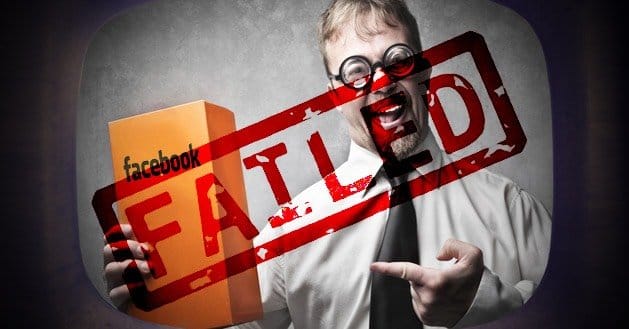 Written by ContentPowered.com
Written by ContentPowered.com Facebook has a huge audience, and tapping that audience can be intensely profitable for your small business. However, in these days of mass customer disinterest, declining organic reach and high competition, you need to be more competitive than ever. Facebook ads are a great tool, but if you’re running them haphazardly or without a plan, you’re going to see low returns in the best circumstances. Why might your ads be failing to bring in leads, and what can you do to turn them around?
Facebook has a huge audience, and tapping that audience can be intensely profitable for your small business. However, in these days of mass customer disinterest, declining organic reach and high competition, you need to be more competitive than ever. Facebook ads are a great tool, but if you’re running them haphazardly or without a plan, you’re going to see low returns in the best circumstances. Why might your ads be failing to bring in leads, and what can you do to turn them around?
1. No Call to Action
One of the easiest traps to fall into as a marketer using Facebook ads is believing that the ad itself is a call to action. After all, users know it’s an ad, right? They can see it right there in the sidebar, clearly labeled. Ads are there for one purpose; advertising something, whether it’s a product to buy or a page to like. It stands to reason that users will see it, recognize it for what it is and interpret the call to action correctly.
Unfortunately, this is hurting you in two ways. First, it’s giving the general audience far too much credit. The average user may not differentiate between an ad and a non-ad post. If they do, they may not put the critical thinking necessary to divine the intent of the ad. The second way the lack of call to action hurts you is the way Facebook charges you for an ad. They charge for everything; impressions, clicks, likes, shares, conversions and whatever else they feel like adding to the list. One user, clicking your ad and then poking around on your page without actually liking or buying anything costs you money but fails to bring you profit.
Make sure you use at least some of the limited text space in your Facebook ads to tell users exactly what’s expected of them. Post an intriguing hook and add a line like “Want to know more? Click and like our page to find out.” Of course, you’re going to want to do a lot of testing to discover what phrasing and language is more attractive. In fact, a huge part of creating a successful ad is taking the time to refine your language into an art form.
2. No Marketing Budget
You have to spend money to make money. Nowhere is this more true than with paid ads on Facebook. Your budget determines the spread of your ads, the time they run and the eventual quality of your conversions.
You can, if you know what you’re doing with targeting and language, make an insane return on investment from only $1 or $10 in advertising. However, that requires that you know what you’re doing. If your ads aren’t making you money, chances are you’re doing something else wrong besides having a low budget.
Now, this isn’t an invitation to just throw money into ads and let them run for as long as possible. You need to couple a budget with the aforementioned refined language, potent images and precise targeting.
3. Poor Targeting
Too many advertisers target their ads by country and nothing else. That’s not a very good strategy. There are thousands of sub-demographics within a given country. Women or men? Young or old? East coast or west? Urban or rural? Do they like painting? Are they a minority? Are they fashionable? Do they like everything they come across, or are they selective? The questions can go on for days.
Once again this comes back to experimentation and analytics. As you build your audience, you slowly learn more about them, both in general and in specific. In general, you can learn their race, age, gender, location and other such demographics. In specific, you can learn their hobbies, their behaviors and their interests.
You need to narrow down your ads as much as possible. It does no good to market to the whole country. Narrow it down to market to just 21-year-old women who love shoes and you’ll have a better time selling shoes and getting users to like your shoe blog. Narrow it down even further by looking at the habits and hobbies of the users who actually engage with your blog.
Facebook’s natural and paid reach are both on the decline for marketers. You need to learn that volume is not the solution to your problems. Sure, if you have a 5 percent conversion rate, reaching 10,000 people is better than reaching 100 people. However, it’s not the volume that you can easily control. Your ads, with the same budget, might reach 10,000 people no matter what. Your targeting is what controls whether your conversion rate is 5 percent or 15 percent.
4. Putting Too Much Stock on Likes
Many businesses consider the Facebook like to be the most important metric. It is, in a sense, in that more users does tend to mean more engagement. The issue that comes up is the quality of those likes, however. A page with 100 engaged users is going to have a better return than a page with 10,000 disinterested users.
With proper targeting, you can build a smaller audience made up of people more likely to engage and convert. This frees you up to run fewer ads based on gaining likes, and more ads based on converting those engaged users into blog readers or product buyers.
You can control a few of the indicators that point to a disinterested user. For example, even if you’re not paying for a click farm to give you 10,000 likes, you may still receive some of those likes from users if you’re marketing in India, China and developing nations. These click farm accounts benefit from liking as much as possible, which makes the account look more legit in the eyes of Facebook security and obfuscates their intent as paid clicks.
Unfortunately, there’s no way to block targeting users who have a high rate of liking pages. Some users just like everything they come across, even if they aren’t malicious about it. Facebook sees these legitimate users and decides to market to them, as they’re more likely to like your page. Of course, that doesn’t mean they’re more likely to actually engage, which is the problem. To some extent, you’re going to have to deal with a certain percentage of disinterested users. It’s just a fact of marketing on Facebook.
5. Not Using the Right Kind of Image
As mentioned above, you pay Facebook for a number of metrics, including the basic ad click, even if the user doesn’t follow through and convert by liking your page or buying your product.
General advice usually states to make a compelling image that gets as many users as possible clicking the ad. This is fine, to an extent, but if you go too far you open yourself up to issues. Once again, it’s a problem of quality versus quantity. An image so compelling everyone clicks through just to see the whole picture may get you a huge number of ad clicks, but an image a little less attractive but a little more refined might bring in more users looking to actually like your page and your product.
You’ll have to test this by running different ads with different images and comparing the engagement between them. Split testing and detailed analytics will be your friends the whole way through. In fact, testing is the key to successful ads, no matter what part of the process is letting you down.





Blake P.
says:I’ve poured hundreds into Facebook without seeing a dollar. I’m starting to think it’s a waste of time…